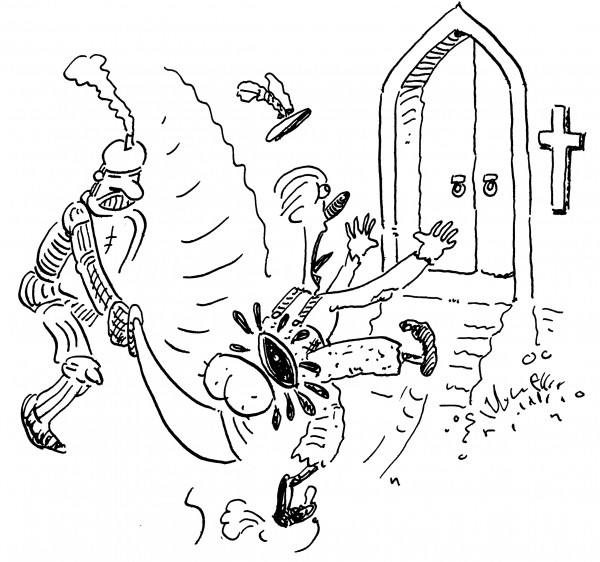
- Slug Signorino
The nuns in Catholic school taught us there was such a thing as sanctuary—the police cannot arrest a suspect in a church. Does this concept have a basis in law, or is it just a social custom that can be discarded on a whim? —Rich Illing
The nuns in Catholic school taught us lots of things. I remember being told all motorists had to yield the right of way to post office trucks, which, being federal, ruled the road. The sisters’ teachings on sanctuary were equally well-founded. Yes, the notion of sanctuary has a historical basis, but for anyone thinking it’s a modern get-out-of-jail-free card, think again.
Religious sanctuary began long before Christianity. It was used in ancient Greece and Rome to designate places bestowing a degree of sacredness on those entering, and who were therefore not to be mistreated. Sometimes the sanctuary zone was an altar or a temple, sometimes an entire town.
The Bible in several places discusses the right to sanctuary for accidental homicides in order to prevent vengeance killings. Other cultures sometimes designated natural areas as sanctuaries, such as woods or lakes. The Romans had problems with folks overusing sanctuaries, and tried several times to limit or abolish the concept. But sanctuary eventually became established in canon and secular law.
Belief in religious sanctuary spread throughout Western civilization, although different cultures had different ways of enforcing it. The Germans obliged the fugitive to surrender if the authorities promised to forgo capital punishment, whereas the Carolingians denied sanctuary for those under death sentence.
The English went whole hog with the concept: Beyond the basic sanctuary provided by any church, they used royal charters to create sanctuary zones extending a mile in all directions around certain abbeys, with roadside stone crosses marking the boundaries. In Scotland, one clan received its own cross marker, which, according to legend, exempted those reaching it from capital punishment for homicide (but not premeditated murder). Depending on the place, fugitives might have to grab a certain doorknocker, sit in a designated stone chair, ring a special bell or wear particular clothing to indicate they sought protection. In most cases, weapons had to be checked at the door.
Sanctuary rarely meant permanent immunity from prosecution, and it never applied to religious crimes. In canon law, it protected those accused of violent crimes for a limited time only, affording a measure of due process in a time when punishment was often abrupt and bloody. In England, claimants were generally allowed just 40 days of protection, after which they had to surrender or go into exile; the chartered sanctuaries, though, apparently conferred lifetime immunity for all crimes except sacrilege.
Sanctuary was often violated. Sometimes, civil authorities would cut off food supplies to the church, storm it or set it on fire to force the issue. Nonetheless, something like a thousand people a year took refuge in churches throughout most of English history.
As the power of the church waned, so did the protection of sanctuary. In the 15th century, Edward IV dragged the Duke of Somerset and 20 of his men from a church and beheaded them. In 1623, James I abolished sanctuary for criminal offenses, and in 1697, William III did the same for civil offenses. Other western European countries followed suit.
In the United States, religious sanctuary was never recognized in state or federal law. The only legal equivalent in most places now is the granting of political asylum in embassies and consulates.
That hasn’t stopped people from claiming sanctuary. Examples:
- GIs occasionally sought sanctuary during the Vietnam War. The most publicized episode took place in Honolulu in 1969, when dozens of AWOL servicemen and their supporters fled to local churches, possibly inspired by a similar movement in Boston the prior year. The result was what you’d expect: After giving the unwilling soldiers a couple weeks to change their minds, MPs raided the churches, breaking down doors as needed.
- During the investigation of the Tawana Brawley rape case in New York in the late 1980s, Brawley’s mother claimed sanctuary at a series of Baptist churches to avoid testifying before a grand jury. Police, presumably to avoid inflaming the black community, made no move to grab her, and eventually she fled the state.
- A few U.S. churches over the years have granted sanctuary to illegal aliens, including some fleeing Central American violence in the 1980s and others facing religious persecution in Indonesia today.
- Canada has been trying to oust a former KGB agent and an AWOL American soldier living in churches for several years.
- In Norway, in 2007, Iranian asylum seeker Shahla Valadi, tired of hiding from deportation in church sanctuaries for seven years, had an RV fitted out as a “rolling church” so she could travel to a demonstration in Oslo. The ploy worked—not only was she not nabbed and deported, she was granted asylum less than two months later.
Lesson: even in our profane age, the powers that be are still reluctant to desecrate a church.